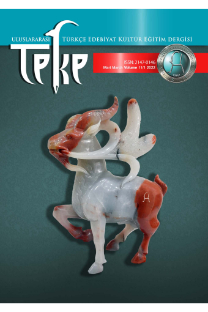Vuslat ve denge: Dürdane Hanım ve intibah romanlarında anlatısal ögelerin hamiliği
Bu çalışma, Tanzimat dönemi yazarlarının; çağın politik, psikolojik ve sosyolojik durumu gereği Batı etkisinde kalan toplumu, bu yeni etki alanı için hazırlamak ve eğitmek adına üstlendikleri toplum mühendisliği görevini göz önünde bulundurarak dönemin roman anlayışını değerlendirir. Dahası dönemin romanlarındaki anlatıcının kurmaca karaktere kavuştuğu/dönüştüğü üçüncü tekil şahıs aracılığıyla söz konusu görevin gerçekleşmesini araştırır. Bu araştırma için malzeme olarak Ahmet Mithat Efendinin Dürdane Hanım ve Namık Kemalin İntibah romanları seçilmiştir. Araştırma boyunca, seçilen romanlarda anlatıcıların okuyucuyu kurmaca dünyası içinden yönlendirmeleri ve bu yönlendirmenin nedenlerinden bahsedilerek Tanzimat romanlarındaki anlatısal ögelerin ve betimlemelerin toplumu eğitmeye ve yönlendirmeye hizmet edişi gösterilir. Böylece, Türk edebiyatında ilk romanların toplumsal bilinç kurmaya etkisi irdelenir.
Meeting and balance: The patronage of narrative elements in the novels Dürdane Hanim and intibah
This study evaluates the perception of novel in Tanzimat era taking into consideration the authors social engineering mission at that time which they admit in order to prepare and educate the society about the new impact area when the society was exposed to the Western influence because of the political, psychological and sociological conditions of the period. Moreover, it investigates the accomplishment of concerning mission through the third- person singular whom the narrator is gathered to/transforms into. As materials for this article, the novels Dürdane Hanım by Ahmet Mithat Efendi and İntibah by Namık Kemal are chosen. Throughout the article, by dealing with the narrators directings of the audience from the fictive world and the reasons of this direction, it is manifested that narrative elements and depictions in Tanzimat novels serve the purpose of educating and directing the society. Thus, in setting of social identity, the role of the initial novels in Turkish literature will be examined.
___
- AHMET MİTHAT. (1999). Dürdane Hanım. Ankara: Akçağ Yay.
- EAGLATON, T. (2004). Edebiyat Kuramı: Giriş. İstanbul: Ayrıntı Yay.
- ESEN, N. ve KÖROĞLU, E. (2006). Merhaba Ey Muharrir! Ahmet Mithat Üzerine Eleştirel Yazılar. İstanbul: Boğaziçi Üniversitesi Yay.
- FLUDERNIK, M. (2005) Histories of Narrative Theory (II): From Structuralism to the Present. A Companion to Narrative Theory [Elektronik Versiyon]. Blackwell Publishing. http://unmas-library.ac.id/ebook_unmas/A_Companion_To_Narrative_Theory.pdf den erişildi.
- KÖROĞLU, E. (2012). Aşırılık, Suç ve Düzeni (Tefrika) Romanda Yazmak: Dürdane Hanım Örneği [Elektronik Versiyon]. İstanbul Üniversitesi Türk Dili ve Edebiyatı Dergisi, 47, 127-170.
- http://www.journals.istanbul.edu.tr/iutded/article/viewFile/1023022347/1023020883 den erişildi.
- NAMIK KEMAL. (2008). İntibah. İstanbul: Özgür Yay.
- ÖZTÜRK, V. (2012). Gerçekten Kurmacaya: Gazeteci Ahmet Mithattan Yazar Ahmet Mithata [Elektronik Versiyon]. İstanbul Üniversitesi Türk Dili ve Edebiyatı Dergisi, 47, 171-183. http://asosindex.com/journal-article-fulltext?id=29777&part=1 den erişildi.
- PARLA, J. (2002). Babalar ve Oğullar: Tanzimat Romanın Epistemolojik Temelleri. İstanbul: İletişim Yay.
- TANPINAR, A. H. (2010). XIX. Asır Türk Edebiyatı Tarihi. İstanbul: Yapı Kredi Yay.
- ISSN: 2147-0146
- Yayın Aralığı: Yılda 4 Sayı
- Başlangıç: 2012
- Yayıncı: Cengiz Alyılmaz
Sayıdaki Diğer Makaleler
Vuslat ve denge: Dürdane Hanım ve intibah romanlarında anlatısal ögelerin hamiliği
Türkçe ders kitaplarında yer alan hikâye türündeki metinlerin üst yapı açısından değerlendirilmesi
Ahlat arkeolojik kazısı çini örnekleri ve el sanatları sergisi üzerine
Fazıl Ahmet Bahadır'ın tarih Türkçe konuşur adlı şiirinin metinlerarasılık bağlamında incelenmesi
“AHLAT ARKEOLOJİK KAZISI ÇİNİ ÖRNEKLERİ VE EL SANATLARI SERGİSİ” ÜZERİNE
DEDE KORKUT KİTABI’NDA GEÇEN AĞAYIL VE KAYTABAN KELİMELERİNİN ETİMOLOJİSİ ÜZERİNE
ALTAY, YENİSEY VE MOĞOLİSTAN YAZITLARI ÜZERİNE NOTLAR
Ahmet Mithat Efendi'nin karı koca masalı adlı eserinde evlilikurumu
JIGSAW-IV TEKNİĞİNİN YABANCI ÖĞRENCİLERİN TÜRKÇEDEKİ TEMEL ZAMANLARI ÖĞRENMELERİ ÜZERİNDEKİ ETKİSİ
